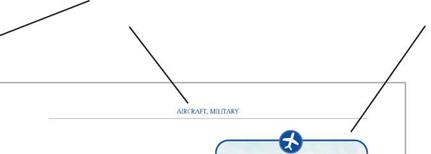READERS’ GUIDE
|
This guide tells you what you will find in the five volumes of Flight and Motion and explains how to use the set. There are 135 articles arranged alphabetically in Volumes 1 through 5. They cover science and technology, aviation and air flight, space and spaceflight, general topics, and biographies of notable people. The pages of every article are color-coded according to their main theme (see pages 4-5 for a list of articles by theme). These are the colors used for the different themes: SCIENCE AND TECHNOLOGY AVIATION AND AIR FLIGHT SPACE AND SPACEFLIGHT GENERAL TOPICS BIOGRAPHY AND PROFILE Each volume has its own glossary, which explains terms used in the volume, and an index to help find references to particular subjects within the volume. Volume 5 has a comprehensive glossary and a full index that cover all five volumes. In Volume 5, there are two additional, specific indexes: one for aircraft and spacecraft, and one for people. Volume 5 also contains lists of books and Web sites, places to visit, a measurement conversion chart, and a time line. |
|
A colored tab appears at the beginning of each article to indicate its main theme. |
|
Color-coding by theme helps readers find |
|
articles of interest to them. |

|
o An observation balloon rises above the 1862 Battle of Fair Oaks, fought in Virginia during the American Civil War (1861-1865). Balloons such as this one were the first military aircraft. |
|
The first air combat took place during World War I (1914-1918). Pilots shot at one another with pistols, shotguns, and machine guns. The next step was to attach a machine gun, which the pilot aimed at an enemy, to the airplane itself. By 1915 fighter planes had been developed with synchronized machine ^ guns that fired bullets between th whirling propeller blades. Celebrated fighter pilots, known as aces, created successful air fighting tactic By the end of World War I, there were two main types of military airplane. Fighters flewat around 125 miles per hour (200/kilometers per hour) at heights of/rip to 22,000 feet (6,700 metersk/Larger, heavier bombers flew more slowly, around 100 miles per hour 60 kilometers per hour), but they ‘could fly for up to 8 hours. |
|
Captions give information about photographs and diagrams. |

![]() Focus boxes highlight interesting topics, people,
Focus boxes highlight interesting topics, people,



the beginning of the first page of the article and in the running head.
In the 1930s the agile biplane was replaced by the much faster monoplane. This new kind of aircraft had an enclosed cockpit, a streamlined metal body, and a high-performance engine. Fighter planes such as the German Messerschmitt Bf 109 and Curtiss P-40 had a top speed of over 350 miles per hour (563 kilometers per hour). Bombers, such as Boeing’s B-17, were slower at around 280 miles per hour (450 kilometers per hour), but they could fly for 2,000 miles (3,220 kilometers). The bombers carried 6,000 pounds (2,725 kilograms) of bombs that could be dropped accurately on city targets.
O (From left) An A-10 Thunderbolt II, F-86 Sabre, P-38 Lightning and P-51 Mustang fly in a flight formation during an air show at Langley Air Force Base, Virginia, on May 21, 2004. The formation displayed four generations of U. S. Air Force fighters.
or events relevant to the subject of the article.
Tech Talk boxes offer scientific explanations, statistics, and other technical details.
|
|
Length: 31 feet (9.45 meters)
Wingspan: 28 feet (8.53 meters) Weight: 12,250 pounds (5,557 kilograms)
Motor: Reaction Motors XLR-11- RM-3 four-chamber rocket engine Fuel: Mixture of alcohol and liquid oxygen
Thrust: 6,000 pounds
(2,722 kilograms/26,500 newtons)
The Bell X-1 was shaped like a bullet for maximum streamlining. Its wings and tail plane were conventional in design. (In the 1940s, other experimental high-speed aircraft had strange shapes.) The stubby-winged X-1, however, had hidden secrets. Its wings were thin but very strong. A stabilizer, which the pilot could move up and down, improved stability and control. Later supersonic planes were also fitted with stabilizers.
4_____________ /
Some entries in this encyclopedia have a colored background. These are featured entries about special people, inventions, or topics.
The See Also box at the end of each article lists related articles in this encyclopedia for readers who would like more information. Each article is preceded by a color-coded bullet point to indicate the article’s main theme.











